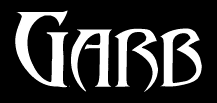| |
Welcome to the garb section!
Garb is period costuming and what we wear to events. It can be expensive
or amazingly cheap, difficult to make or remarkable easy. If you can afford,
it can also be no work at all because there are a million places to buy
pre-made or custom costumes. There are three basic types: Peasant,
Middle
Class, and Noble. Peasant costuming
is recommended because it's the cheapest and easiest to make. Unless you
can sew well and/or have a great deal of time and money, don't choose the
other two classes for your first project.
Peasant
This section will be split
into two parts: Men and Woman, but first, garb basics must be addresses.
Colour:
Most fabrics were dyed with vegetable dyes because it was easily accessible
and inexpensive enough for the peasants. This rules out bright or obviously
modern hues. Period colours include but are not limited to: bright
red, rust, yellow, saffron, marigold, orange, brown, kelly green, forest
green, moss green, bright blue, dark blue, and "faded" blue. Never use
purple, it was reserved for royalty.
Fabric: Cotton was
expensive during the Elizabethan era, however, it is commonly used. Any
fabric that looks "home spun" or like linen are the best. Thankfully, this
fabric is generally inexpensive. Don't use velvet, denim, anything stretchy,
satin, or anything glittery. Remeber, most fabric was made by hand so if
it doesn't look like a peasant would have worn it, stay away from it.
Men: Peasant men usually
wore slops or simple pants and a tunic.
Women: Women's clothing
is slightly more complicated, depending on what period you want to recreate.
Early periods, women wore long tunic gowns which were quite easy to make.
For the more experienced, there are the basic peasant skirts, chemises
(blouse/slips) and the peasant bodice. The skirts are painfully easy to
make, as well as the chemise. The bodice can be difficult for the first-time
costumer. Try looking at the many patterns available for purchase on the
web or look through a good costuming resource book. For some suggestions
you can check out our shopping guide.
Middle Class
The middle class dressed
as well as they could afford. The fabrics were finer than the homemade
cloth of the peasants, but not as grand as the Nobles. The colours were
slightly darker, but not as dark as the upper classes. Darker shades of
red, blue and green are all good choices in addition to the colours in
the peasant section. Fabric choices include linen, corduroy and sometimes
velvet. Go easy on the trim, nothing too fancy or expensive.
Men: Middle
class men were merchants, shop owners, businessmen and tavern owners. Depending
on the period you're going for, you can either make a more expensive looking
tunic and pants or (for the traditionally Elizabethan look) a doublet,
shirt, and slops.
Women: As with the
men, tunics are acceptable for earlier periods. In the Elizabethan era,
the corset emerges among the middle class women. There are sources on the
net (see the links page) that include instructions
on how to make an Elizabethan corset. The bodice laces in the back, as
opposed to the front in the peasant bodice. This was because they had a
maid or a handful of household servants to lace them in. Corduroy is a
wonderful middle class fabric for bodices and skirts. There are 2 skirts,
one overskirt to match the bodice in fabric and colour, and and underskirt
perhaps of a contrasting colour or fabric. The overskirt is open in the
front to let the underskirt show. These are not difficult to make and instructions
can be found in various books or on the net.
Nobles
C o m i n g S
o o n
Back
to Main |

